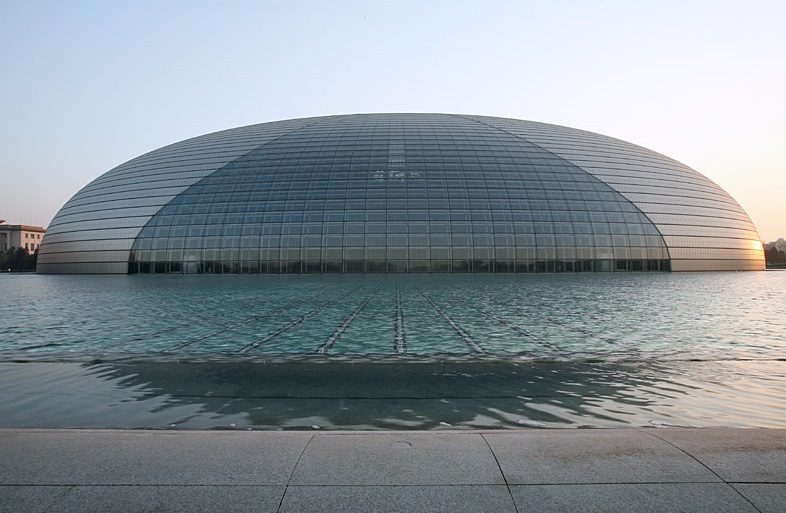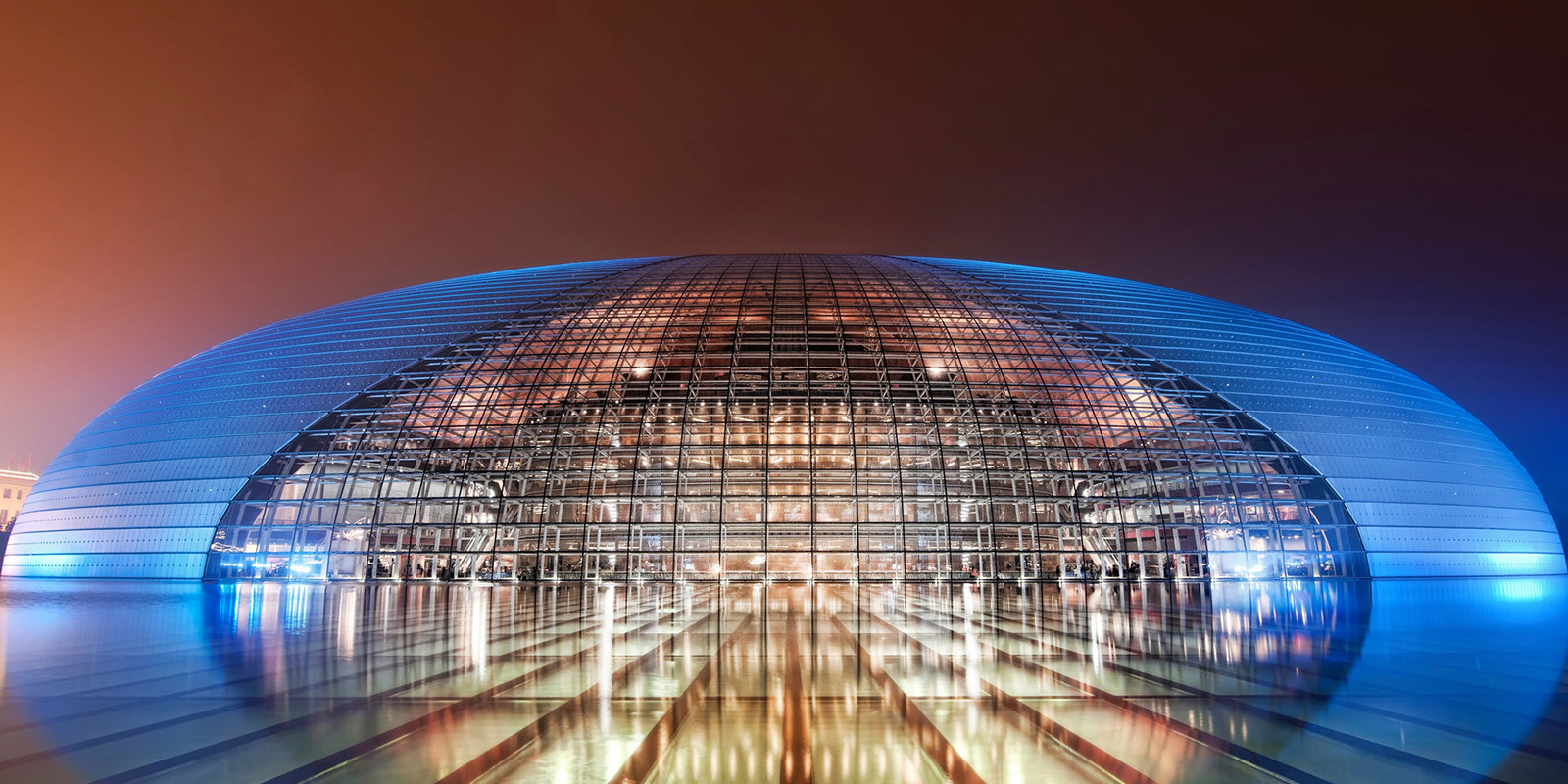National Centre for the Performing Arts, Beijing
Contents |
[edit] Introduction
The National Centre for the Performing Arts (NCPA) is located in the centre of Beijing, China. It is known by its nickname ‘the giant egg’, because of its distinctive flattened-dome shape.
The building is situated like an island in the middle of an artificial lake of 35,500 sq.m. Around the lake a green ring of 39,000 sq.m is intended to isolate the building from the noise of the city.
The NCPA was designed by French architect Paul Andreu, and houses an opera house capable of seating 2,398, a concert hall seating 2,019, a theatre seating 1,035, and a smaller multi-function theatre. Construction work began in 2001, and the inaugural concert was held in December 2007.
Its location provoked some controversy because of its proximity to Tiananmen Square, the Great Hall of the People and the Forbidden City. Andreu argued that, as an important international city, Beijing should include modern as well as ancient traditional Chinese architecture. The inclusion of the lake and the green ring were part of the design solution to complement the ancient architecture and prevent the contrast being too jarring.
[edit] Design and construction
The building is an ellipsoid dome of titanium and glass, designed to resemble an egg floating on water, or a water droplet. Andreu designed the building to be an iconic feature that would be instantly recognisable.
The dome has a maximum span of 213 m (in its east-west direction), a minimum span of 144 m (north-south), and reaches a height of 46 m. The total area of the building is 12,000 sq.m.
It is covered with 18,000 titanium plates, integrated with more than 1,000 sheets of ultra-white glass; a low-iron glass with high light transmission. The titanium shell is divided in two by a curved glass curtain, gradually widening from the top to the bottom where it measures 100 m in width. When illuminated at night this gives the impression of a stage curtain being pulled back, while during the day the glass curtain bathes the interior in light.
Visitors reach the building through the Underwater Corridor, a hallway that stretches beneath the lake from the green ring. The glass ceiling allows light to pass through from the water, producing a shimmering effect.
The large open foyer has a floor made of stone from 10 different regions in China. The interior walls are lined with tens of thousands of panels made of Brazilian rosewood.
[edit] Costs controversy
The building’s initial planned cost was 2.688 bn yuan. However, on completion, this had escalated to more than 3.2 bn yuan. It has been suggested it will be close-to impossible to recuperate the investment. Each individual seat, when averaged out, is worth around 500,000 yuan. On top of this, the huge costs of cleaning the external surface mean that the Chinese government faces subsidising the building for many years. Responding to this though, the Chinese government claimed that the building was never intended to be a for-profit venture.
[edit] Find out more
[edit] Related articles on Designing Buildings Wiki
- Apple Park.
- Beijing Greenland Center.
- Beijing National Stadium.
- Building of the week series.
- CCTV Headquarters.
- China Philharmonic Hall.
- City Hall, London.
- Forbidden City.
- Guggenheim Museum, Bilbao.
- Niteroi Contemporary Art Museum.
- Phoenix International Media Center, Beijing.
- Rose Museum.
- Royal Albert Hall.
- Sage Gateshead.
- Sydney Opera House.
- Types of dome.
- Unusual building design of the week.
- Xili Sports and Cultural Centre.
[edit] External resources
- Arcspace - National Centre for the Performing Arts
Featured articles and news
Grenfell Tower fire – eight years on
A time to pause and reflect as Dubai tower block fire reported just before anniversary.
Airtightness Topic Guide BSRIA TG 27/2025
Explaining the basics of airtightness, what it is, why it's important, when it's required and how it's carried out.
Construction contract awards hit lowest point of 2025
Plummeting for second consecutive month, intensifying concerns for housing and infrastructure goals.
Understanding Mental Health in the Built Environment 2025
Examining the state of mental health in construction, shedding light on levels of stress, anxiety and depression.
The benefits of engaging with insulation manufacturers
When considering ground floor constructions.
Lighting Industry endorses Blueprint for Electrification
The Lighting Industry Association fully supports the ECA Blueprint as a timely, urgent call to action.
BSRIA Sentinel Clerk of Works Training Case Study
Strengthening expertise to enhance service delivery with integrated cutting-edge industry knowledge.
Impact report from the Supply Chain Sustainability School
Free sustainability skills, training and support delivered to thousands of UK companies to help cut carbon.
The Building Safety Forum at the Installershow 2025
With speakers confirmed for 24 June as part of Building Safety Week.
The UK’s largest air pollution campaign.
Future Homes Standard, now includes solar, but what else?
Will the new standard, due to in the Autumn, go far enough in terms of performance ?
BSRIA Briefing: Cleaner Air, Better tomorrow
A look back at issues relating to inside and outside air quality, discussed during the BSRIA briefing in 2023.
Restoring Abbotsford's hothouse
Bringing the writer Walter Scott's garden to life.
Reflections on the spending review with CIAT.
Retired firefighter cycles world to raise Grenfell funds
Leaving on 14 June 2025 Stephen will raise money for youth and schools through the Grenfell Foundation.
Key points for construction at a glance with industry reactions.
Functionality, visibility and sustainability
The simpler approach to specification.
























